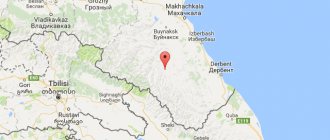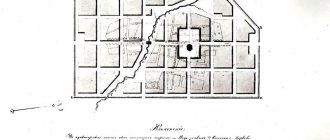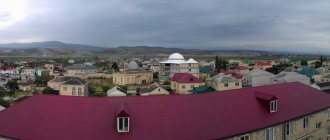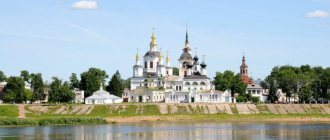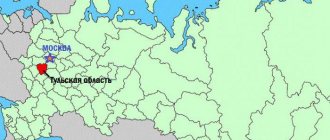What holiday is it today?
December 16, 2021, Thursday
Today are holidays, events: Events that happened on December 16 in the world, in different years Tomorrow: Day of Strategic Missile Forces Day of Employees of the State Courier Service Memorable date in the military history of Russia: Capture of the Ochakov fortress in 1788
Today is the Orthodox holiday of the Prophet Zephaniah. Reverend Savva of Storozhevsky, Zvenigorod. Martyr Angelis... Tomorrow: Great Martyr Barbara and Martyr Juliania of Iliopolis. Venerable John of Damascus...
Today is a national holiday: Day of World Silence and Silence... Tomorrow: Barbarian Day...
Districts and urban districts[ | ]
| № | Name | Flag | Coat of arms | OKATO | OKTMO | Area, km² | Population, people (2021) | Administrative center | Population of the center, people |
| 1e-06 | Districts (municipal areas) | ||||||||
| 1 | Babaevsky district | 19 205 | 19 605 | 9200 | ↘18 855[5] | Babaevo city | ↗11 416[5] | ||
| 2 | Babushkinsky district | 19 208 | 19 608 | 7760 | ↘11 069[5] | village named after Babushkin | ↘4017[6] | ||
| 3 | Belozersky district | 19 210 | 19 610 | 5398 | ↘14 050[5] | Belozersk city | ↘8464[5] | ||
| 4 | Vashkinsky district | 19 212 | 19 612 | 2884 | ↘6379[5] | Lipin Bor village | ↘3673[6] | ||
| 5 | Veliky Ustyug district | 19 214 | 19 614 | 7720 | ↘52 874[5] | Veliky Ustyug city | ↗31 078[5] | ||
| 6 | Verkhovazhsky district | 19 216 | 19 616 | 4260 | ↘12 599[5] | Verkhovazhye village | ↘5013[6] | ||
| 7 | Vozhegodsky district | 19 218 | 19 618 | 5750 | ↘14 083[5] | Vozhega village | ↘6045[5] | ||
| 8 | Vologda district | 19 220 | 19 620 | 4552 | ↘51 999[5] | Vologda city | ↘308 530[5] | ||
| 9 | Vytegorsky district | 19 222 | 19 622 | 13100 | ↘23 432[5] | Vytegra city | ↘10 116[5] | ||
| 10 | Gryazovets district | 19 224 | 19 624 | 5030 | ↘31 694[5] | town of Gryazovets | ↘14 797[5] | ||
| 11 | Kaduysky district | 19 226 | 19 626 | 3260 | ↘16 522[5] | urban village Kaduy | ↗11 023[5] | ||
| 12 | Kirillovsky district | 19 228 | 19 628 | 5400 | ↘14 386[5] | Kirillov city | ↘7371[5] | ||
| 13 | Kichmengsko-Gorodetsky district | 19 230 | 19 630 | 7061 | ↘14 967[5] | village Kichmengsky Gorodok | ↘6421[6] | ||
| 14 | Mezhdurechensky district | 19 232 | 19 632 | 3624 | ↘5187[5] | Shuiskoye village | ↘2220[6] | ||
| 15 | Nikolsky district | 19 234 | 19 634 | 7476 | ↘19 202[5] | Nikolsk city | ↗7960[5] | ||
| 16 | Nyuksensky district | 19 236 | 19 636 | 5167 | ↘8291[5] | village of Nyuksenitsa | ↘4244[6] | ||
| 17 | Sokolsky district | 19 238 | 19 638 | 4165 | ↘47 238[5] | Sokol city | ↘36 067[5] | ||
| 18 | Syamzhensky district | 19 240 | 19 640 | 3900 | ↘7824[5] | Syamzha village | ↗4029[7] | ||
| 19 | Tarnogsky district | 19 242 | 19 642 | 5100 | ↘11 015[5] | village Tarnogskiy Gorodok | ↘5365[6] | ||
| 20 | Totemsky district | 19 246 | 19 646 | 8393 | ↘21 868[5] | city of Totma | ↘9652[5] | ||
| 21 | Ust-Kubinsky district | 19 248 | 19 648 | 2400 | ↘7445[5] | Ustye village | ↘3875[6] | ||
| 22 | Ustyuzhensky district | 19 250 | 19 650 | 3600 | ↘16 067[5] | Ustyuzhna city | ↘8284[5] | ||
| 23 | Kharovsky district | 19 252 | 19 652 | 3560 | ↘13 275[5] | Kharovsk city | ↘8650[5] | ||
| 24 | Chagodoshchensky district | 19 254 | 19 654 | 2409 | ↘11 404[5] | urban-type settlement Chagoda | ↘5777[5] | ||
| 25 | Cherepovets district | 19 256 | 19 656 | 7640 | ↘38 635[5] | Cherepovets city | ↘312 091[5] | ||
| 26 | Sheksninsky district | 19 258 | 19 658 | 2528 | ↘33 097[5] | village Sheksna | ↘18 488[5] | ||
| 26.000002 | Cities of regional significance[8] (urban districts) | ||||||||
| 27 | Vologda city | 19 401 | 19 701 | 117 | ↘315 494[5] | Vologda city | ↘308 530[5] | ||
| 28 | Cherepovets city | 19 430 | 19 730 | 121 | ↘312 091[5] | Cherepovets city | ↘312 091[5] |
Seasons
Seasons, four periods of the year (spring, summer, autumn and winter) characterized by certain average temperatures. The period during which the Sun passes through one of these sectors is called the season. Spring in the Northern Hemisphere and autumn in the Southern Hemisphere begin when the Sun passes through the initial circle of declination and its right ascension is 0° (vernal equinox). Summer in the Northern Hemisphere and winter in the Southern Hemisphere occur when the sun's right ascension is 90° (summer solstice). Autumn in the Northern Hemisphere and spring in the Southern Hemisphere begin when the sun's right ascension is 180° (autumnal equinox). The beginning of winter in the Northern Hemisphere and summer in the Southern Hemisphere is considered to be the winter solstice, when the direct ascension of the Sun is 270°... Next: Seasons. Russian folk calendar. Monthly words...
Main streets on the map of Vologda
A street map gives an idea of the main highways connecting areas into a single urban space. The most significant and busiest streets of the city:
- Mira street . Starts at the square. Babushkina, where the railway station and bus station are located. It runs through the city center to Orlova Street on the Vologda River embankment. An important transport route for the city, there are many historical monuments and commercial establishments here.
- Mozhaisky street . Former name Zavokzalnaya. It originates from the viaduct bridge connecting Mira Street with Poshekhonskoe Highway, ends in the Flax Factory area, stretches along the railway tracks, crossing the bridge over the Shogrash River. On the street there is a locomotive depot, a carriage depot, shops, and residential buildings.
- Leningradskaya street . It follows in a western direction from the fortress walls of the Vologda Kremlin. Until 1974, it ended at the Arkhangelsk direction railway line; after the commissioning of a viaduct across the railway tracks, the street was significantly extended to the GPZ (Bearing Plant) microdistrict. At the end of the street there is a city trolleybus depot. This is a modern highway with high capacity for all types of urban transport.
- Street named after Alexandra Klubova . Former Verkhnevologodskoe highway. The direction of the street is from east to west, it starts in the city center from Pobeda Avenue and runs through the industrial zones of the city. There are almost no residential buildings on it, but “Stanko” is located. The street crosses a local railway line.
- Herzen Street . One of the main central arteries on the map of Vologda. It starts from Mira Street (from the Vinterovsky Bridge over the Zolotukha River) and ends at the railway line leading to Moscow. At the beginning of the street there is a beautiful building of the Regional Administration, along it there are many wooden architectural monuments.
- Preobrazhenskogo Street is located in the southern part of the city. After the closure of the railway crossing in the area of Tovarnaya Street, it lost its transport significance, but is currently being reconstructed and in the near future will become one of the main latitudinal highways of the city, connecting through Govorovsky Passage with Mozhaisky Street.
- Karl Marx Street . Located in the riverside part of the city. It starts from Chernyshevsky Street and crosses many streets: Dobrolyubova, Samoilo, Sammera, Fryazinovskaya, Severnaya and others. It ends at the timber exchange on the banks of the Vologda River. On this street there is a park for labor veterans, large shopping centers, and in the area of Fryazinovskaya street there are multi-story modern buildings.
Pay attention to the satellite map, it is almost entirely green - this means that the city is very rich in vegetation. There are many cozy parks, squares, and beautiful alleys. Every summer, participants in the city project “Vologda – a Blooming City” decorate streets and squares with picturesque flower beds, original ornaments of fresh flowers and green spaces.
Folk calendar about every day
Every day one season always replaces another and this determines a person’s way of life. In connection with this, a folk calendar was formed in which there were practically no nameless, unmarked days. Every day was special, had its own purpose. All this was determined by climate conditions and astrological phenomena.
A calendar is a system for counting periods of time. The first calendars arose a long time ago, in ancient times, because there was a need to measure time. The word calendar comes from the Latin words caleo - to proclaim and calendarium - debt book. This is due to the fact that in Ancient Rome the beginning of each month was especially proclaimed, and because it was customary to pay debts on the first day of the month. Different peoples counted time differently. Some calendars are based on the changing phases of the moon - lunar calendars; in others - the change of seasons - sunny; in others, the length of the year was coordinated with the change of seasons, and the counting of months was associated with the phases of the Moon. Such calendars are called lunisolar.
In Rus', the calendar was called a monthly calendar. Every day, the month book covered the entire year of peasant life, “describing” day by day, month after month, where each day had its own holidays or weekdays, customs and superstitions, traditions and rituals, natural signs and phenomena. The cyclical nature of the calendar is reminiscent of human life, where spring is youth, summer is heyday, autumn is the time of harvesting fruits (it’s good if there are some, otherwise you can live your life without collecting fruits), winter is the time of wisdom and peace. This cyclicality and rhythm determined the way of life of the farmer. The folk calendar was an agricultural calendar, which was reflected in the names of the months, folk signs, rituals and customs. Even the determination of the timing and duration of the seasons is associated with real climatic conditions. Hence the discrepancy between the names of the months in different areas... Next: Folk calendar...
Crime
Is life without crime conceivable? Without visible - obviously, yes. One can even remember that the notorious “dashing 90s” passed through Vologda in a very tangential way. It is no coincidence that even then the city did not endow the country with ANY significant criminal authority. The explanation is simple: a lot in the region is connected with units of the Northern Sea Fleet, aviation and strategic missile forces. Many military towns and villages are still classified.
In addition, the penitentiary system is very powerful here. An eloquent example: the well-known “zero kilometer” is located in Vologda. This is the starting point on the way to the most important financial and economic centers of the North-West.
Zero kilometer
As a result, it is quite appropriate to say that the Vologda law enforcement agencies are controlling the situation. However, it is possible that crime has been legalized. Or he went underground. Options are possible. But they remain only assumptions. The problem of nationalism does not arise here either - Vologda is practically mono-ethnic, 97% of the population is Russian.
Fishing calendar for every day
The fishing calendar should not be taken as an absolutely indisputable truth. Fish biting is greatly influenced by a whole range of natural factors, as well as the influence on the nature of man himself. You must not forget that the fish’s bite depends and is determined not only by the calendar dates and biological cycles of their life, reflected in the calendar, but also, no less, by the state of their habitat; the bite also depends on weather conditions: air and water temperatures, cloudiness, wind direction and strength, etc... Next: Fishing calendar...
Orthodox calendar about every day
Orthodox calendar: Orthodox, Church and Christian holidays.
The church year is an alternation of weekdays and holidays. On weekdays, a person is called to work “by the sweat of his brow to earn his bread.” Holidays are given in order to feel liberation, to rise above the bustle and routine of the world, to feel involved in the highest of worlds, “where there are no illnesses, sorrows and sighs, but endless life.” Since ancient times, holiday cycles have been associated with the seasons. The pagans associated them with the worship of the forces of nature, the cult of which in the Old Testament was replaced by gratitude to the Creator for the universe. And although the connection between holidays and the seasons has not completely lost its power, since God is present in everything, in the plant and animal world, in human works, it nevertheless faded into the background, giving way to a spiritual foundation built on the Sacred Scriptures. The history of Orthodox holidays dates back to the times of the Old Testament. Each of the Orthodox holidays is dedicated to the remembrance of the most important events in the life of Jesus Christ and the Mother of God, as well as the memory of saints... Next: Orthodox calendar...
Russian folk calendar for every day
The word “sign” comes from the word “notice”, i.e. observe. As a result of observing what happens around a person every day, he accumulates life experience. This knowledge was passed down from generation to generation, carefully preserved and people trusted it as a sacred book. Many signs have come to us from the depths of centuries without losing their knowledge. Each of us is free to choose: to dismiss all this as an absurd superstition or to take a closer look at the signs and take the centuries-old experience of generations more seriously. Most of us, when taking exams, ask them to scold them, boasting about some kind of good fortune or luck, spit so as not to jinx them or knock on wood, take a detour if a black cat crossed the road, are afraid of the number 13 and much more. And who among us does not have lucky things, numbers? Who has never resorted to the help of fate at least once in their life, who has not believed in secrets? It’s as if everything connected with signs is hidden somewhere deep in our subconscious. Often we remember them mechanically, unconsciously, or just as a joke. But, undoubtedly, the signs contain a lot of accurate knowledge and practical wisdom of our ancestors. They cover all the characteristic, often difficult to perceive, natural phenomena. Signs have preserved a lot of what was in old folk holidays and customs; they help predict the weather, grow crops... Next: Folk signs...
Economy and industry of Vologda
For a long time, the basis of the economy was trading activity. But in the middle of the last century, the industrial component of economic life began to actively take shape. With the commissioning of large enterprises:
- State Bearing Plant No. 23;
- ;
- Optical-mechanical plant;
- Vologda Dairy Plant
The industrial potential of the regional center has increased significantly. Currently, the following industries are well developed in Vologda:
- mechanical engineering;
- food industry;
- light and processing industry;
- woodworking;
- construction.
Small and medium-sized businesses are developing rapidly.
In the regional center, antiquity and modernity are surprisingly organically intertwined. Vologda has a rich cultural life, there are 5 professional theaters (regional Drama, Youth Theater, "Teremok" - puppet theater, Chamber Drama Theater, Children's Musical Theater). The Vologda Regional Philharmonic and large libraries were opened.
Vologda residents are friends with sports, conduct public international activities and know how to have a good rest. Vologda has a rich, interesting history, but no less rich and wonderful future.
Holiday calendar, dates and events of the year
All state and professional holidays in Russia, including significant World and International holidays, and other equally interesting holidays and events about every day.
The holiday has always kept pace with the history of mankind. Social time can be divided into three types: everyday life (weekdays), weekends and holidays. Everyday life is a series of practices repeated day after day and every day (work). Weekends are regular breaks from the rush of everyday life. It is believed that on weekends a person should restore his strength after working days. Day off, non-working day. A holiday is a day of celebration established in honor or in memory of someone or something. A day or series of days celebrated by the church in memory of a religious event or saint... Next: Calendar...
Transport connections of the Vologda region, roads and routes
On the map of the Vologda region with its districts, you can see that most of the roads are local highways. The total length of roads in the region is 15.6 thousand km. Of these, 641 km are on federal highways. Main highways of the region:
- M8 "Kholmogory" (Moscow-Arkhangelsk);
- A114 “Novaya Ladoga” (Vologda-St. Petersburg);
- A119 (Vologda-Medvezhyegorsk).
The length of the railway track in the region is 1889 km. River shipping is developed in the region. One of the largest ports on the Volga-Baltic route is located in Cherepovets. An international airport is located in the same city.
Prayer book, Orthodox prayers for every day
Prayer is the most powerful means for healing all illnesses - both physical and mental. Prayers can be laudatory or grateful, petitionary and repentant. If we have offended God, sinned, we must ask Him for forgiveness, that is, repent. Such prayers are called repentant prayers. If everything is fine with us, if we and our loved ones are healthy and prosperous, if we have a place to live, something to wear, something to eat, we must glorify and thank God for this. Such prayers are called praise or thanksgiving. If some misfortune, illness, trouble or need happens, you need to ask God for help. Such prayers are called petitionary... Next: Orthodox prayers...
Zodiac, astrological, eastern calendar. Zodiac signs
In ancient times, to establish the calendar, priests used knowledge of the positions of all the planets. Before the reform of Peter 1, the New Year was celebrated on the Day of the Autumn Equinox. On this day, according to ancient legend, the most peaceful treaty was concluded between the Great Race (ancient Slavs) and the Great Dragon (ancient Chinese) and it was approximately 7518 years ago... For the ancient Slavs, the calendar month corresponded to the lunar cycle from new moon to new moon, taking into account such Thus, the relationship of the entire annual cycle with astronomical and natural phenomena. There was no coherent calendar system. The main natural phenomena are still considered to this day to be the days of the solar equinox and solstice - the Slavic holidays Maslenitsa, Kupala, Ovsen and Kolyada. But during the time of Peter 1, all ancient Slavic calendars were abolished and a new Western European calendar from the Nativity of Christ (Julian calendar) was introduced, while the beginning of the calendar was moved to January 1. The Julian calendar (old style) did not take leap days into account and accumulated one extra day every 128 years. After the October Revolution in 1918, the Gregorian calendar (new style) was introduced in Russia, according to which an amendment of 13 days was introduced. The calendar of the ancient Slavs was based on two planets: the Sun and the Moon. And now they don’t use anything at all. The calendar has become static. There is no such thing as the calendar, it turns out, resting on some planet. Nobody even knows about it. There are just some standard numbers, there are months and holidays. The calendar is based on the Sun and Moon. Why is this so? Because these two luminaries influence the Earth. The Earth revolves around the Sun, and the Moon revolves around the Earth. And these two luminaries create the atmosphere on the planet. From here the calendar is built... Next: Astrological calendar...
Sights of the city of Vologda
Ancient, cozy, kind-hearted Vologda is famous for its beauty and unique appearance. There is only one such city in Russia! Thousands of tourists from Russia and abroad come to get acquainted with its unique sights. The most interesting places in the city are:
- Vologda Kremlin , located on the picturesque bank of the Vologda River in the city center. Its fortress walls and buildings became the “calling card” of the city;
- next to the entrance to the Kremlin stands the majestic St. Sophia Cathedral , which was erected by order of Ivan the Terrible himself (XVI century). This is the first building in Vologda built not from wood, but from stone. On the map with houses it is listed at 15 Orlova Street;
- The decoration of the Kremlin Square of Vologda is the Resurrection Cathedral , introduced in the 18th century in the Baroque architectural style. Currently it houses the Vologda Art Gallery;
- on Kremlin Square, at house 12, opposite the buildings of the Vologda Kremlin, there is the Museum of Vologda Lace . It presents the beautiful creations of Vologda lacemakers and highlights the history of lace making;
- The house of Peter I stands on the high bank of the Vologda River; it is famous for the fact that Tsar Peter Alekseevich stayed there several times during his visits. The small stone building with its unique architecture has become one of the symbols of the city. The house is located at Sovetsky Prospekt, 47;
- Among more than four dozen churches in Vologda, the Church of Alexander Nevsky , located near the Kremlin Square on Orlova Street, 12, stands out. In the middle of the 16th century, the miraculous icon of St. Nicholas the Wonderworker was kept within its walls;
- on the outskirts of the city, on Monastyrskaya Street, 2, there is an active Spaso-Prilutsky Monastery . Anyone can visit this unique architectural complex.
There are many monuments of wooden architecture in Vologda. Beautiful wooden buildings are concentrated mainly in the central area of the city. This is the Zasetsky house (Leningradskaya St., building 12), the Puzan-Puzyrevsky house (Gertsen St., building 35), the Volkov house (Leningradskaya St., building 30), the house-museum of the merchant Samarin with the famous carved palisade. The city has the most interesting museums, for example, the Vologda Link Museum , the Pharmacy Museum, etc.
Dream books online, interpretation of dreams
A dream book is nothing more than an interpreter of dreams and dreams, a translator of dreams. Since ancient times, people have been using dream books; dreams have always been given great importance, and people have often noticed the prophetic properties of some dreams. The dream book can become your faithful assistant every day and throughout your life, thanks to the dream interpreter you can always make the right decisions, the dream book will help you resist temptations in time, and will warn you against wrong steps and frivolous actions. Further…
